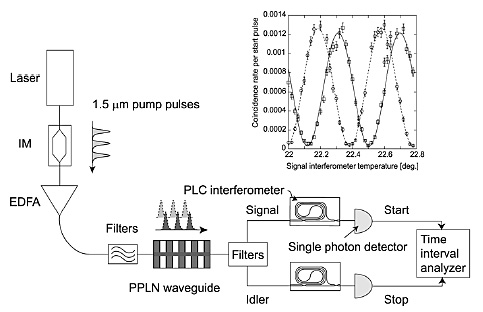Optical Science Laboratory, *NTT Photonics Laboratories
Cascaded second-order nonlinearity (χ(2): χ(2)) process in a single periodically poled lithium niobate (PPLN) waveguide
is a well known technique for wavelength conversion in the 1.5-µm
band [1]. Recently, this technique has been used in a quantum optics experiment,
in which squeezed vacuum pulses were generated [2]. Here, we report the
generation of time-bin entangled photon pairs using the χ(2): χ(2) process in a single PPLN waveguide.
Figure 1 shows the setup. A 1551.1 nm continuous lightwave was modulated
into a pulse train with a 100 ps width and a 500 MHz repetition frequency
using an intensity modulator (IM). The pulses were amplified by an erbium-doped
fiber amplifier (EDFA), filtered to eliminate amplified spontaneous emission
noise from the EDFA, and then launched into a PPLN waveguide. In the PPLN
waveguide, the 1.5-µm pump pulse train was converted to a 780-nm
pulse train via SHG (second harmonic generation), and simultaneously, the
generated 780-nm pulse train worked as a pump for spontaneous parametric
down conversion. As a result, we generated sequential time-bin photon pairs
[3], whose state is approximately given by  . Here,
. Here, ![]() denotes the state of a photon in the temporal position k and the mode z (=s : signal, or i : idler), and N is the number of pulses for which the phase coherence of the pump is preserved. The output light from the PPLN waveguide was introduced into optical filters, which separated the signal and idler photons. The signal and idler photons were then input into 1-bit delayed interferometers. We can observe a two-photon interference fringe by measuring the coincidence counts between the signal and idler channels while changing the phase of the interferometers.
denotes the state of a photon in the temporal position k and the mode z (=s : signal, or i : idler), and N is the number of pulses for which the phase coherence of the pump is preserved. The output light from the PPLN waveguide was introduced into optical filters, which separated the signal and idler photons. The signal and idler photons were then input into 1-bit delayed interferometers. We can observe a two-photon interference fringe by measuring the coincidence counts between the signal and idler channels while changing the phase of the interferometers.
As shown in the inset of Fig. 1, we observed two-photon interference fringes
with visibilities up to as high as 97 %. Thus, we successfully confirmed
the generation of high-purity entanglement based on the proposed scheme.
[1] M. H. Chou et al., IEEE Photon. Technol. Lett. 11 (1999) 653.
[2] K. Hirosawa et al., Phys. Rev. A 80 (2009) 043832.
[3] H. de Riedmatten et al., Phys. Rev. A 69 (2004) 050304(R).
 |
||
|